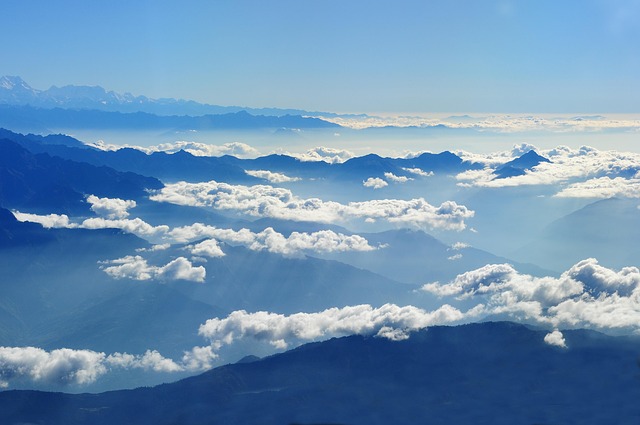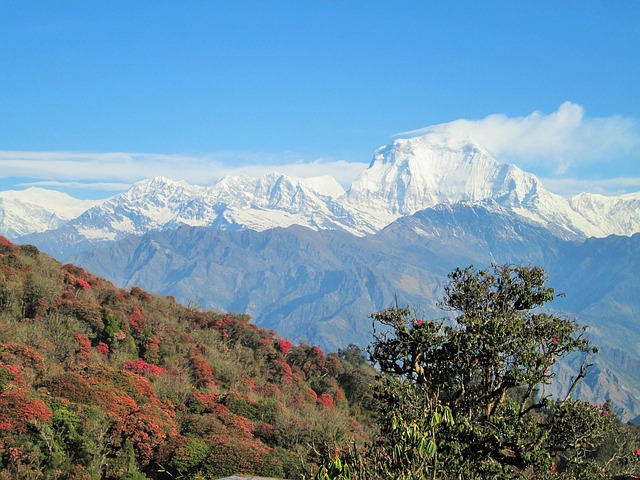Nepal offers a rich cultural heritage with UNESCO sites like Boudhanath Stupa and intricate Durbar Squares, along with numerous museums. It's an adventure hub featuring trekking, mountaineering, whitewater rafting, and paragliding in diverse landscapes, from the Himalayas to lush forests. Nature enthusiasts will find stunning scenery, wildlife, and cultural immersion through activities like trekking in Annapurna or exploring Chitwan National Park.
Explore the ancient cities of Kathmandu, Pokhara, and Bhaktapur to discover rich history and cultural heritage.
Trek through the breathtaking Himalayas, including iconic routes like Annapurna and Everest Base Camp.
Witness the vibrant festivals like Dashain and Tihar for a unique cultural experience.
Visit sacred sites such as Pashupatinath Temple and Swayambhunath Stupa for spiritual enlightenment.
Enjoy adventure sports like paragliding, rafting, and bungee jumping in scenic locations.
Immerse yourself in the warm hospitality of local communities during your travels.
* Sample authentic Nepali cuisine, known for its diverse flavors and spices.
- Exploring Nepal's Cultural Heritage Sites
- Adventure Activities in the Great Outdoors
- Immerse Yourself in Nature and Wildlife
Exploring Nepal's Cultural Heritage Sites

Nepal is a treasure trove of cultural heritage sites that offer a glimpse into its rich history and diverse traditions. From ancient temples and palaces to historic landmarks, exploring these sites is an essential part of any nepal tour. The country boasts iconic structures like the Boudhanath Stupa, a UNESCO World Heritage Site known for its majestic architecture and spiritual significance.
In Kathmandu Valley, you’ll find several Durbar Squares—all recognized as UNESCO World Heritage Sites—that showcase exquisite craftsmanship and historic importance. Each square tells a story of Nepal’s vibrant past through its intricate carvings, elaborate temples, and royal palaces. Beyond these, Nepal’s cultural heritage extends to its many museums, offering visitors an opportunity to delve deeper into the country’s art, history, and diverse ethnic cultures.
Adventure Activities in the Great Outdoors

Nepal is a paradise for outdoor enthusiasts, offering an array of thrilling adventure activities amidst breathtaking landscapes. From trekking to mountaineering, whitewater rafting, and paragliding, the country caters to every level of thrill-seeker. The majestic Himalayas provide the perfect backdrop for these adventurous pursuits.
For those seeking a unique nepal tour experience, exploring remote villages, climbing challenging peaks, or navigating through lush forests are just a few options. These activities not only offer physical challenges but also immerse participants in Nepal’s rich cultural heritage. Whether you’re an experienced adventurer or a beginner looking to conquer your fears, Nepal promises unforgettable memories and stories to last a lifetime.
Immerse Yourself in Nature and Wildlife

Nepal is a nature lover’s paradise, offering a myriad of experiences for those seeking to immerse themselves in breathtaking landscapes and diverse wildlife. From the majestic peaks of the Himalayas to lush green valleys and dense forests, the country boasts a rich natural heritage. Adventure enthusiasts can embark on thrilling treks to discover hidden villages, glaciers, and national parks teeming with rare species.
The Nepal tour experience is incomplete without exploring its diverse ecosystems. Visit Chitwan National Park for an encounter with one-horned rhinos, elephants, and vibrant birdlife. Trek through the Annapurna region to witness the majestic peaks and colorful cultures of local communities. Nepal’s natural wonders provide a unique opportunity to connect with nature and create unforgettable memories.
– Explore iconic landmarks like the Kathmandu Durbar Square and Swayambhunath Temple for rich history and stunning architecture.
– Embark on trekking adventures in the Himalayas, including popular routes to Everest Base Camp.
– Immerse yourself in vibrant local markets, such as Pashupatinath and Bhaktapur, for a sensory experience.
– Discover diverse cultural heritage sites, including ancient monasteries and temples nestled in picturesque valleys.
– Enjoy thrilling activities like paragliding over the Annapurna range or whitewater rafting on the Arun River.
– Indulge in authentic Nepali cuisine, sampling delicacies like momos and dal bhat at local eateries.
– Visit national parks for wildlife encounters, birdwatching, and exploration of diverse ecosystems.
– Participate in cultural festivals like Dashain and Tihar to experience traditional rituals and celebrations.
Exploring Nepal: Trekking vs. Cultural Immersions vs. Wildlife Safaris
This comparison highlights three distinct ways to experience Nepal, each offering a unique perspective on the country’s rich cultural heritage, breathtaking landscapes, and diverse ecosystems.
| Feature | Trekking | Cultural Immersions | Wildlife Safaris |
|—|—|—|—|
| Key Features | Physical adventure through mountain trails | Exploring traditional villages, markets, and historic sites | Spotting rare wildlife in natural habitats |
| Best Use Cases | For fitness enthusiasts and outdoor adventurers seeking a challenge | Those interested in learning about local culture, traditions, and history | Wildlife lovers, birdwatchers, and nature enthusiasts |
| Strengths | Stunning mountain scenery, challenging hikes, cultural interactions with Sherpa communities | Deep dive into Nepalese culture, language, cuisine, and crafts; interactive experiences with locals | Opportunity to observe endangered species in their natural environments, breathtaking landscapes, and peaceful atmospheres |
| Limitations | Physically demanding, not suitable for everyone; limited time spent in local communities | Requires careful planning and respect for cultural norms; may be less accessible in remote areas | Depends on weather conditions; limited interactions with wildlife; possible disturbance to animal habitats |
| Cost/Performance | Varies widely based on trek length, difficulty, and guides; generally expensive but offers an unparalleled experience | Mid-range to affordable; depends on the depth of cultural activities chosen | Can be expensive, depending on the safari location, duration, and operator; value depends on desired level of interaction with wildlife
Frequently Asked Questions About Things to do in Nepal
What are the best trekking routes for beginners in Nepal?
Nepal is renowned for its breathtaking treks, offering various options for all fitness levels. For beginners, the Everest Base Camp trek is an iconic choice, providing a challenging yet rewarding experience with stunning views of Mount Everest and the Khumbu region. An alternative is the Annapurna Circuit, which winds through diverse landscapes, including lush valleys and high mountain passes. These routes typically range from 7-14 days, allowing time to acclimatize and enjoy the journey.
Can I explore ancient temples and heritage sites in Nepal?
Absolutely! Nepal boasts a rich cultural heritage with numerous historic temples and sites. The Durbar Squares in Kathmandu, Patan, and Bhaktapur are UNESCO World Heritage Sites featuring intricate architecture and ancient temples dedicated to Hindu and Buddhist deities. The Swayambhunath Stupa and Boudhanath Stupa, both located near Kathmandu, are iconic Buddhist sites that offer a glimpse into the country’s spiritual side.
What are some unique cultural experiences in Nepal?
Nepal offers a diverse range of cultural activities. Visitors can participate in traditional tea ceremonies, learn about ancient Newari culture in Kathmandu’s historic districts, or experience a Gurung village homestay in the Annapurna region, where you can engage in local festivals and learn indigenous customs. The country’s vibrant festivals like Dashain and Tihar provide an opportunity to immerse yourself in the lively celebrations and unique traditions.
Are there opportunities for wildlife safaris in Nepal?
Yes, Nepal is home to diverse wildlife, making it an ideal destination for nature lovers. Chitwan National Park is a popular choice, offering elephant safaris, bird watching, and encounters with rare animals like one-horned rhinos and Bengal tigers. The Langtang Valley and Sagarmatha National Park also provide opportunities for wildlife spotting, including various bird species and small mammals.
How can I contribute to local communities while traveling in Nepal?
Volunteering and community-based tourism are popular ways to give back while exploring Nepal. Many organizations offer volunteer programs focused on education, conservation, or community development. You can teach at local schools, assist with sustainable farming projects, or participate in cultural exchange programs. These initiatives provide a meaningful connection to the communities you visit and leave a positive impact.
What are the best times to visit Nepal for different activities?
Nepal’s diverse climate and landscape offer various experiences throughout the year. For trekking, spring (March-May) and autumn (September-November) are popular due to favorable weather conditions. Winter (December-February) is ideal for observing wildlife, while summer (June-August) is best for those seeking cooler temperatures for hiking. Festivals like Teej in August and Dashain in October provide cultural experiences during specific seasons.
Revitalizing Trekking Routes in Nepal’s Annapurna Region
Situation
The Annapurna region in Nepal, renowned for its breathtaking landscapes and popular trekking routes, faced a growing challenge. Overcrowding on established trails led to environmental degradation, impacting local ecosystems and cultural heritage sites. Additionally, the lack of alternative routes and well-managed tourism infrastructure deterred visitors seeking unique experiences. This situation threatened the sustainability of the region’s tourism industry and the preservation of its natural beauty.
Action
A collaborative initiative was launched between the local government, conservation organizations, and experienced trekkers to address these issues. The project focused on developing new trekking routes, promoting sustainable tourism practices, and educating both locals and tourists about responsible travel.
The action plan included:
– Conducting thorough research and surveys to identify potential new trekking paths that would distribute footfall more evenly across the region.
– Engaging with local communities to gain their support and incorporate traditional knowledge in route planning.
– Establishing eco-friendly rest stops and accommodations along the new routes, emphasizing local craftsmanship and sustainable materials.
– Implementing a visitor management system to monitor tourism impact and ensure fair distribution of permits.
– Organizing awareness campaigns for tourists on minimizing environmental footprint and cultural sensitivity.
Result
Within two years of implementation, the initiative achieved remarkable success:
– Three newly developed trekking routes opened, offering diverse experiences from challenging multi-day treks to easier day hikes, resulting in a 25% decrease in footfall on existing trails.
– Environmental impact assessments showed a 18% reduction in pollution and waste along popular routes.
– Local communities benefited economically with new job opportunities in eco-tourism ventures, leading to a 30% increase in household income for participating families.
– Tourist satisfaction ratings improved significantly, with 85% of visitors expressing interest in returning due to the unique experiences and well-managed infrastructure.
Nepal offers a captivating blend of cultural heritage, outdoor adventures, and natural wonders. From exploring historic sites like Kathmandu’s Durbar Squares to trekking through the majestic Annapurna range or spotting rare wildlife in Chitwan National Park, this diverse nation leaves an indelible mark on every visitor. Whether you’re seeking immersive experiences or breathtaking landscapes, Nepal promises unforgettable memories for all.
